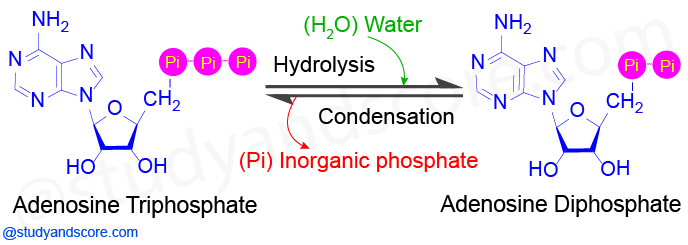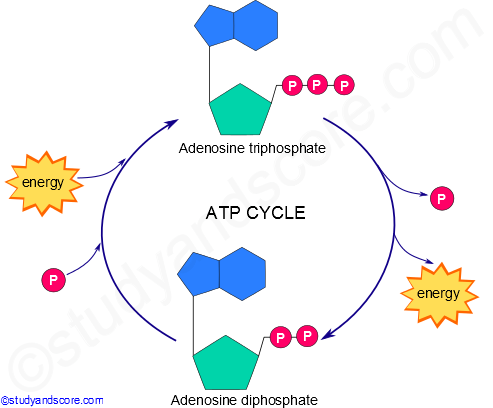Respiration is the organic processes occurring in all the living organisms. During this biological process, the reduced organic compounds are prepared and successively oxidized in an organized method. During respiration free energy is released and quickly stored in the form of Adinosine triphosphate (ATP). These energy rich ATP molecules can be easily used for growth and maintenance of cells.
The cells of all the living organisms require a continuous source of free energy for carrying out the following functions:
Generally free energy is basically derived from the environment. The phototrophs obtain this energy from sun light, whereas chemotrophs get it from phototrophs. Some part of this free energy obtained from the environment is transformed into ATP. ATP is a special carrier of free energy. ATP plays an essential role in the transfer of free energy from energy-yielding to energy-requiring processes of the cells. This ATP breaks down into ADP (Adenosine diphosphate) and Pi (inorganic phosphate) there by donating its chemical energy to carry out the various functions like biosynthesis of macromolecules, transport of ions & molecules and for doing mechanical work.
Formation of ATP-
ADP + Pi + energy → ATP
Expenditure of ATP-
ATP → ADP + energy + Pi

ATP molecules are very much similar to the rechargeable batteries.
Let us analyse how,
The potential energy present in the charged batteries is converted into kinetic energy and heat. If the battery is rechargeable, these batteries can be used gain after charging. Similarly, chemical energy present in the ATP is used up by the cells to carry our functions. After the energy of ATP is used up, it is converted into ADP. ADP can be used again after charging.
In this case ATP is like the recharged battery while ADP is like the used battery. When the terminal phosphate is removed, ATP becomes ADP and the energy which is stored is released to help out some biological function. Later when a phosphate group is added, ADP is recharged back to ATP. This cyclic transformation from ATP to ADP and again back to ATP is called as ATP cycle.
A single molecule of ATP contains 10 carbon, 16 hydrogen, 5 nitrogen, 13 oxygen and 3 phosphorus atoms. The formula of ATP is C10H16N5O13P3. Three phosphate groups are attached to the assembly of adenosine.
The maximum bond energy (7 kcal per mole approx.) is present between second and third phosphate groups. Two covalent bonds also called as phosphoanhydride bonds are present between phosphate groups. These bonds give out energy useful for carrying out various biological functions in living cells. These two phosphoanhydride bonds are written as adenosine–p~p~p or A–p~p~p,
Where,
A is adenosine
p stands for a phosphate group
~ denotes a high-energy bond

The high energy bonds in the ATP are split open by a substance called ATPase. ATPase is also called as ATP splitter because it cuts off the end phosphate group of the ATP molecule and converts the ATP into ADP. When the ATP is split up, it releases great amount of energy which can be used to carry out various cell functions.
When carbohydrates present in the food stuff consumed by us are broken down the energy present in them is released and is used to reattach phosphate molecule to ADP. This turns ADP back to ATP. This way the cycle of bond-breaking and bond-making goes on and on there by storing and releasing energy. This addition and subtraction of a phosphate to ADP is a metabolic process and proceeds in two phases namely catabolism and anabolism. In this case,
Catabolism is the process of degradation of ATP into ADP and Pi
Anabolism is the process of synthesis of ATP from ADP and Pi
The two outer phosphates of ATP have high-energy phosphoanhydride bonds. These bonds are readily transferrable. The terminal phosphate of ATP creates unfavourable repulsions between adjacent negative charges.
The terminal phosphate can be hydrolysed by adding water. This hydrolysis reaction is catalysed by ATP hydrolase enzyme. This hydrolysis yields ADP, inorganic phosphate and about 11-13 kcal/mole of energy. Also the amount of energy released depends on the intracellular conditions. Now, the released inorganic phosphate is stabilized by resonance and hydrogen bonds formed with water.
On the other hand, formation of ATP from ADP and Pi will be reverses hydrolysis reaction. This condensation reaction is energetically unfavourable and must be coupled to other energetically favourable reactions. This reaction is catalysed by ATP synthase enzyme.

ATP is the chief contributor of free energy in all the biological systems and it plays a key role in all energy transfer reactions. It also helps in storing energy required for carrying various metabolic reactions. Generally, an ATP molecule is consumed in less than a minute after its formation. Hence the turnover rate of ATP is very high.
Hope you have liked this post.
Please share it with your friends through below links.
All the very best from Team Studyandscore
“Study well, Score more…”
- Share with your friends! -
Login to post your comment here...
- or with social Account -